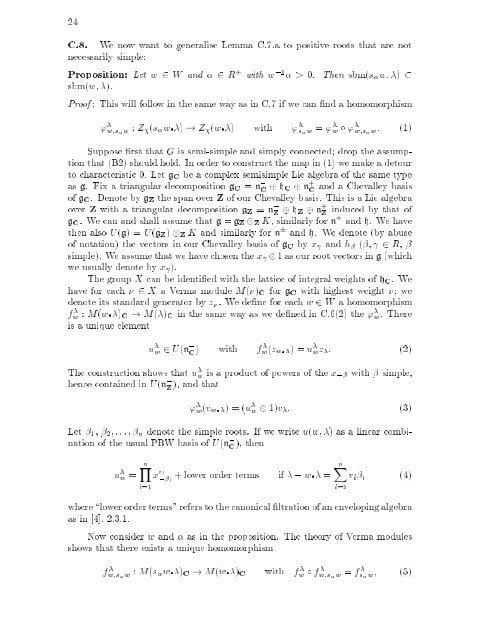subregular nilpotent representations of lie algebras in prime ...
subregular nilpotent representations of lie algebras in prime ...
subregular nilpotent representations of lie algebras in prime ...
You also want an ePaper? Increase the reach of your titles
YUMPU automatically turns print PDFs into web optimized ePapers that Google loves.
24<br />
C.8. We nowwant to generalise Lemma C.7.a to positive roots that are not<br />
necessarily simple:<br />
Proposition: Let w 2 W and 2 R + with w ,1 >0. Then sbm(s w; )<br />
sbm(w; ).<br />
Pro<strong>of</strong> : This will follow <strong>in</strong> the same way as <strong>in</strong> C.7 if we can nd a homomorphism<br />
' w;s w : Z (s w ) ! Z (w ) with ' s w = ' w ' w;s w: (1)<br />
Suppose rst that G is semi-simple and simply connected; drop the assumption<br />
that (B2) should hold. In order to construct the map <strong>in</strong> (1) we make a detour<br />
to characteristic 0. Let gC be a complex semisimple Lie algebra <strong>of</strong> the same type<br />
and a Chevalley basis<br />
<strong>of</strong> gC. Denote by gZ the span over Z <strong>of</strong> our Chevalley basis. This is a Lie algebra<br />
<strong>in</strong>duced by that<strong>of</strong><br />
as g. Fix a triangular decomposition gC = n ,<br />
C hC n +<br />
C<br />
over Z with a triangular decomposition gZ = n ,<br />
Z<br />
hZ n +<br />
Z<br />
gC. Wecan and shall assume that g = gZ Z K, similarly for n and h. Wehave<br />
then also U(g) =U(gZ) Z K and similarly for n and h. Wedenote (by abuse<br />
<strong>of</strong> notation) the vectors <strong>in</strong> our Chevalley basis <strong>of</strong> gC by x and h ( ; 2 R,<br />
simple). We assume that we have chosen the x<br />
we usually denote by x ).<br />
1 as our root vectors <strong>in</strong> g (which<br />
The group X can be identi ed with the lattice <strong>of</strong> <strong>in</strong>tegral weights <strong>of</strong> hC. We<br />
have for each 2 X aVerma module M( )C for gC with highest weight ;we<br />
denote its standard generator by z .Wede ne for each w 2 W a homomorphism<br />
fw : M(w )C ! M( )C <strong>in</strong> the same way aswede ned <strong>in</strong> C.6(2) the 'w . There<br />
is a unique element<br />
u w 2 U(n ,<br />
C ) with f w(zw )=u wz : (2)<br />
The construction shows that uw is a product <strong>of</strong> powers <strong>of</strong> the x, with simple,<br />
hence conta<strong>in</strong>ed <strong>in</strong> U(n ,<br />
Z ), and that<br />
' w(vw )=(u w 1)v : (3)<br />
Let 1, 2;:::; n denote the simple roots. If we writeu(w; ) as a l<strong>in</strong>ear comb<strong>in</strong>ation<br />
<strong>of</strong> the usual PBW basis <strong>of</strong> U(n ,<br />
C ), then<br />
u w =<br />
nY<br />
i=1<br />
x ri<br />
, +lower order terms if , w =<br />
i<br />
nX<br />
i=1<br />
ri i (4)<br />
where \lower order terms" refers to the canonical ltration <strong>of</strong> an envelop<strong>in</strong>g algebra<br />
as <strong>in</strong> [4], 2.3.1.<br />
Now consider w and as <strong>in</strong> the proposition. The theory <strong>of</strong> Verma modules<br />
shows that there exists a unique homomorphism<br />
f w;s w : M(s w )C ! M(w )C with f w f w;s w = f s w; (5)

















